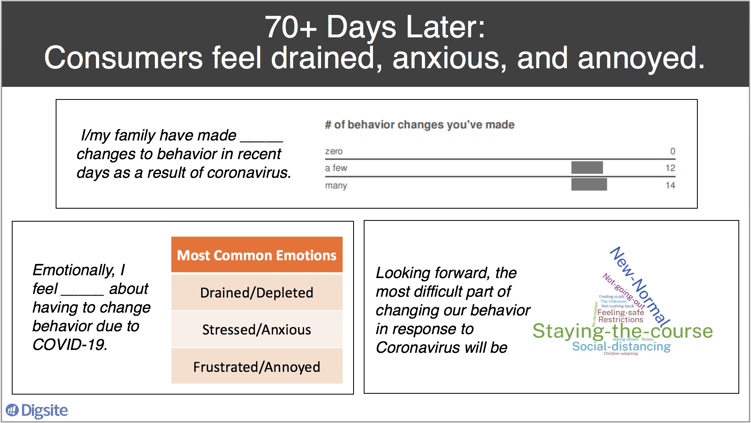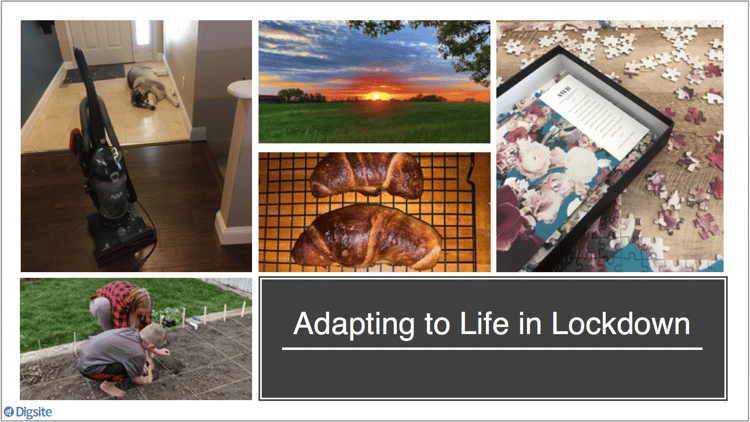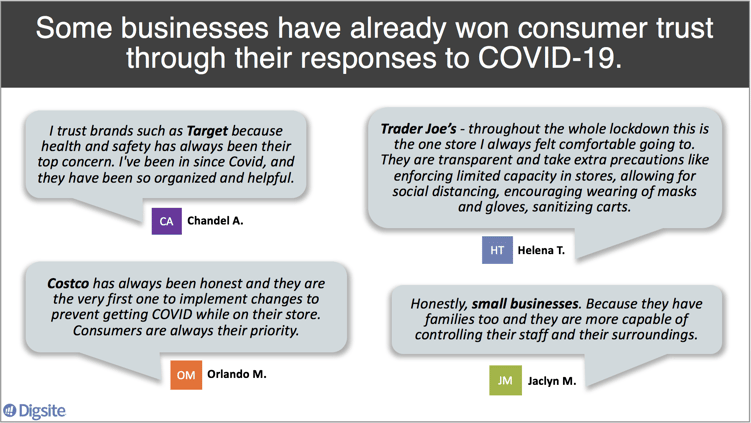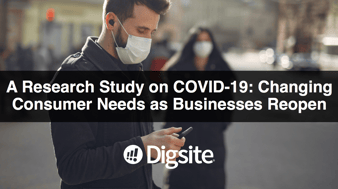More than 70 days. That’s how long people in the U.S. have been on lockdown since COVID-19 hit. Now, as businesses begin to reopen and a bit of normalcy is on the horizon, we are shining our qualitative research spotlight on consumer hopes and expectations as social distancing measures begin to loosen. How can your brand help consumers through this transition and add value during this time of change?
This research study brought 25 consumers, ages 21-60, from a mix of ethnicities and U.S. regions, into a two-day online Digsite community to talk about their changing habits and attitudes, and what they are feeling as social distancing measures are relaxed.
The Feelings Are Real
Although people are adapting to the “new normal” of life during a pandemic, they aren’t generally happy about it. In a study we conducted in March, when it was relatively new, we found that consumers felt anxious, drained, and overwhelmed. Now, in June, consumers still feel anxious and drained – but also annoyed.

When looking to the future, they say the most difficult piece is the long-term expectation of social distancing, not going out, and trying to remain safe. Consumers also continue to be very worried about both COVID-19 and the extreme measures needed to contain it.
Current worries participants voiced include:
- Fear that things will never be back to normal
- Wondering if and when they will be able to travel and go on trips
- Concern about people who aren’t taking precautions or being careful now
- Fear of a second wave of COVID-19, and that it will be worse than the first
- Nervousness that going back to work will pose a risk to their children
Adapting to Life During Lockdown
For this study, we asked participants to share photos representing their lives and the change that has taken place since social distancing and stay-at-home orders went into effect. During a similar exercise in March, participants shared photos that focused on the mechanics of being home and social distancing, such as sanitizing wipes, the home office, and kids at the table doing distance learning. We’re seeing a shift now, as people are adapting and moving into a new phase of life during COVID-19. This time the photos showed a new normal, representing:
- Being home more, having more time to clean
- Spending more time outside
- Learning to make new foods
- Planting a garden
- Working on a puzzle

And while they would love for their lives to return to normal, participants indicated that they are most wary of:
- Staying in hotels
- Going to the gym
- Attending concerts or sporting events
- Letting kids go to in-person camps/lessons/school
- Traveling via planes
- Taking public transportation
Key Findings of the Study
1. Consumers have been socially distancing long enough to move from “sit and wait” to “try something new.”
As shown above, they have adopted behaviors and engaged in hobbies that they are eager to maintain after social distancing measures are relaxed.
Implications: As a business, consider how you can facilitate or at least support and celebrate these changes.
Examples: Free online courses from cooking schools and online workouts from gyms
2. Consumers still feel stressed and exhausted
Being forced to drop so many aspects of normal daily life, stay on high alert for health and safety, and worry about work and money has left nerves frayed.
Implications: Expect consumers to continue to look for entertainment and connection in socially distanced ways, to be looking for small sources of delight, and to be carefully considering where and how they spend their money.
Examples: Social apps like “Together” and Netflix Party help people connect with each other; Mastercard’s “Start something priceless” ad shows people working from home with their adorable dogs; car insurance companies have give-back programs
3. Consumers have only moderate trust in businesses and public spaces to keep them safe in the near term
Though consumers are eager to return to normal activities, their expectations for safety protocols are high.
Implications: Businesses need to go above and beyond the minimum safety standards to win consumer trust, and they should expect the return to some in-person activities to be slow.
Examples: Grocery store distancing and safety measures, such as Trader Joe’s limiting the number of customers in store; ongoing touch-free or one-touch transactions, like food delivery services and gas stations

4. When making purchase decisions, consumers are currently emphasizing social responsibility over style
They report caring more about their purchases supporting local businesses, being healthy and high quality, and caring less about products that are gourmet and fashionable.
Implications: Consider meaningful ways to show your company’s commitment to social responsibility at the community level and expect an ongoing emphasis on function over form.
Examples: Uber free rides for frontline medical workers; Orgain Shakes for Heroes program; contraction of the fashion industry
5. Months of social distancing, plus uncertainty about what’s to come, have tempered expectations for the near future
Hopes and aspirations for the next year are modest and can be as simple as hoping kids can go back to school, or looking forward to seeing friends again in person. Consumers are fearful of additional waves of COVID-19 and the long-term measures that will need to be adopted to manage it.
Implications: There is pent-up demand for products and service limited by social distancing. Consumers want to eat out, travel, go to theme parks, etc., but the fear of the unknown is dampening the demand.
Examples: Amusement parks like Disney World and Universal Studios are reopening, but turnout isn’t there yet
As precautions and decisions around COVID-19 continue to evolve, so will the behavior of consumers. Now more than ever, consumers need brands to help deliver meaning and hope during a time of change. While brands may have varying research budgets to innovate during this time, Digsite will continue to support the industry with free research and resources to help your team address market needs.
Hear from consumers themselves in our latest on-demand webinar, A Research Study on COVID-19: Changing Consumer Needs as Businesses Reopen.






